Your Cold Emails Aren't Getting Through: Email Deliverability Issues Cold Outreach Teams Face
Stop blaming subject lines — the infrastructure problems killing your cold email results
Blogby JanAugust 18, 2025

Your sales team just crafted 1,000 perfect cold emails. Compelling subject lines, personalized messaging, clear value propositions. But when you check the results a week later, only 23 people opened them and 2 responded.
Before you blame your copywriting, consider this brutal reality: 17% of cold outreach emails never reach any inbox at all. They vanish due to bounces, spam filtering, and sender reputation damage that most sales teams don't even know exists.
Email deliverability issues cold outreach teams face aren't just about lost opportunities - they're about compound damage. Every bounced email, spam complaint, and blacklist warning creates a downward spiral that makes future campaigns even less effective. The result? Your domain reputation tanks, emails automatically route to spam folders, and your entire outbound strategy collapses.
Recent research reveals disturbing trends: average open rates dropped from 36% in 2023 to just 27.7% in 2024. Meanwhile, 95% of cold email campaigns fail to generate meaningful responses. But here's what most sales leaders miss - the problem isn't always the message. It's whether the message arrives at all.
Bad contact data doesn't just waste time - it destroys your ability to send emails. When you send messages to invalid addresses, your email bounce rate impact climbs. When bounce rates exceed 5%, major email providers like Gmail and Outlook start flagging your domain as potentially harmful. Once you're on their watch list, even perfect emails to valid addresses get filtered out.
This isn't a problem you can solve with better copywriting or more follow-ups. It requires understanding the technical infrastructure that determines whether your emails reach prospects or disappear into spam folders forever.
The Invisible War Against Your Emails
Every time you hit send, your message must pass through multiple checkpoints designed to block unwanted emails. Cold email deliverability problems start with this gauntlet that most sales teams don't realize they're fighting.
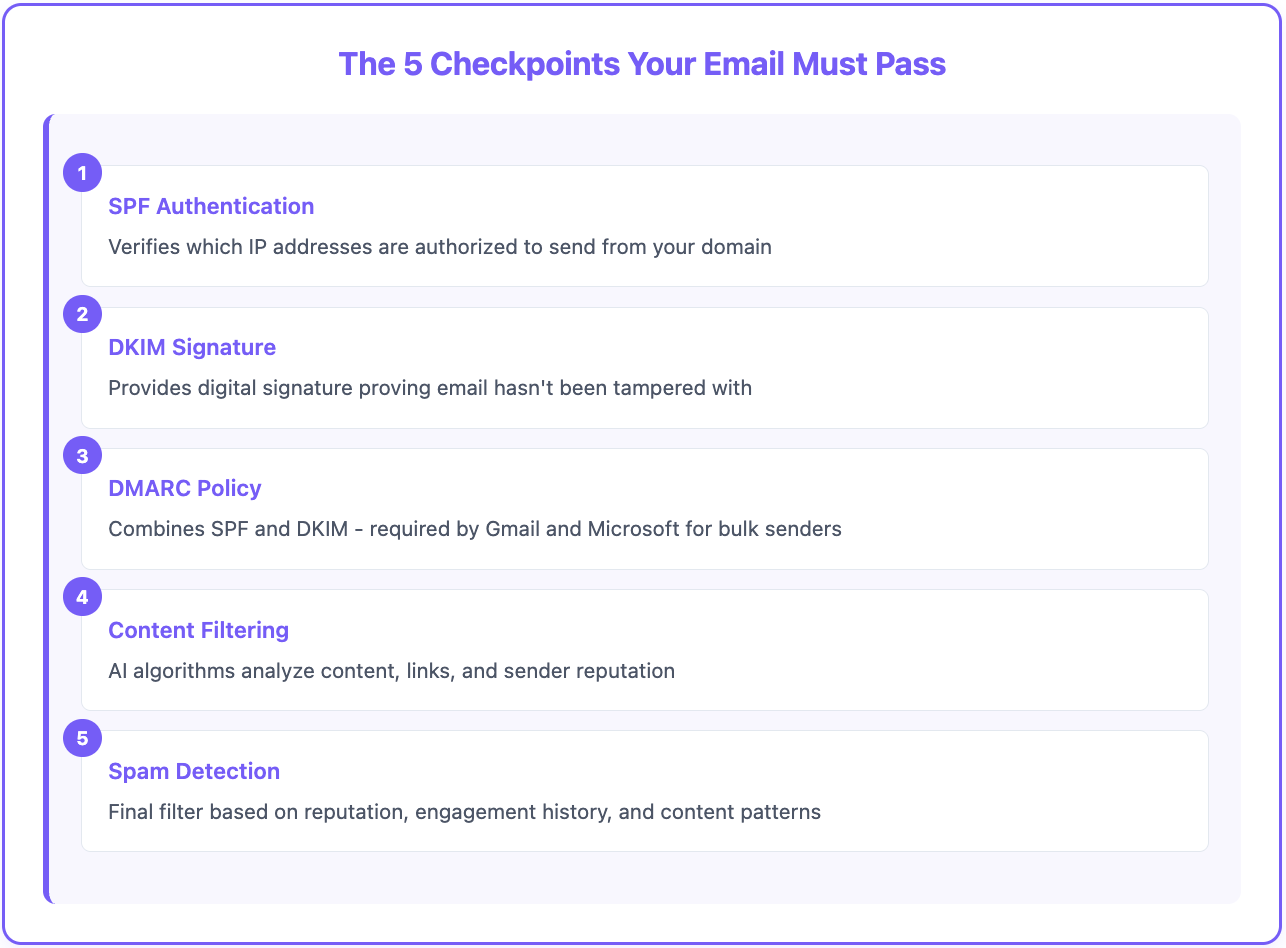
Authentication: Your Email's Digital Passport
Before your email even reaches a spam filter, it must prove legitimacy through email authentication protocols. These technical standards verify that emails actually come from the domains they claim to represent.
SPF (Sender Policy Framework) tells receiving servers which IP addresses are authorized to send emails from your domain. Without proper SPF setup, servers immediately become suspicious. DKIM (DomainKeys Identified Mail) provides a digital signature proving your email hasn't been tampered with during transmission.
DMARC (Domain-based Message Authentication, Reporting and Conformance) combines SPF and DKIM into a comprehensive policy. As of 2024, Gmail requires DMARC for bulk senders, and Microsoft began enforcing it in 2025. Emails that fail authentication standards automatically bounce, classified as policy failures before they're even evaluated for spam.
Many sales teams send cold emails without realizing their domain lacks proper authentication. The result? Authentication failures account for a significant portion of email deliverability issues cold outreach teams blame on other causes.
Content Filtering: The Spam Detection Maze
Once authentication passes, your email content gets analyzed by sophisticated spam detection algorithms that have become increasingly aggressive.
Content analysis examines multiple factors simultaneously: text-to-image ratios, suspicious link patterns, spam trigger words, and overall message structure. What makes this challenging is that filtering criteria constantly evolve as spammers adapt their tactics.
Traditional spam trigger words like "free," "guaranteed," and "limited time" still activate filters, but modern algorithms analyze context and sender reputation together. A trusted sender might get away with promotional language that would doom a new domain.
Link inclusion significantly impacts deliverability. Cold emails with tracked links are more likely to get filtered because service providers like Google often filter emails with external links to protect users. This forces sales teams to choose between tracking engagement and ensuring delivery.
The Reputation Economy
Sender reputation damage represents one of the most misunderstood aspects of email deliverability issues cold outreach teams face. Email providers assign complex scores to domains and IP addresses based on historical sending behavior.
Reputation factors include: bounce rates, spam complaints, sending volume patterns, and recipient engagement levels. Providers like Gmail track reputation continuously, and a single bad campaign can damage scores that took months to build.
New domains face particular challenges because they lack sending history that providers use to assess trustworthiness. Sending large volumes immediately from a new domain triggers automatic suspicion, often resulting in messages being filtered regardless of content quality.
Shared IP addresses create additional complications. When multiple companies send emails from the same server, one sender's poor practices can affect everyone else's reputation. This explains why dedicated IP addresses, despite higher costs, often improve deliverability for serious email senders.
When Bad Data Becomes a Digital Death Sentence
Email bounce rate impact extends far beyond individual message failures. High bounce rates signal to email providers that senders don't maintain quality contact lists, often indicating spam-like behavior even when intentions are legitimate.
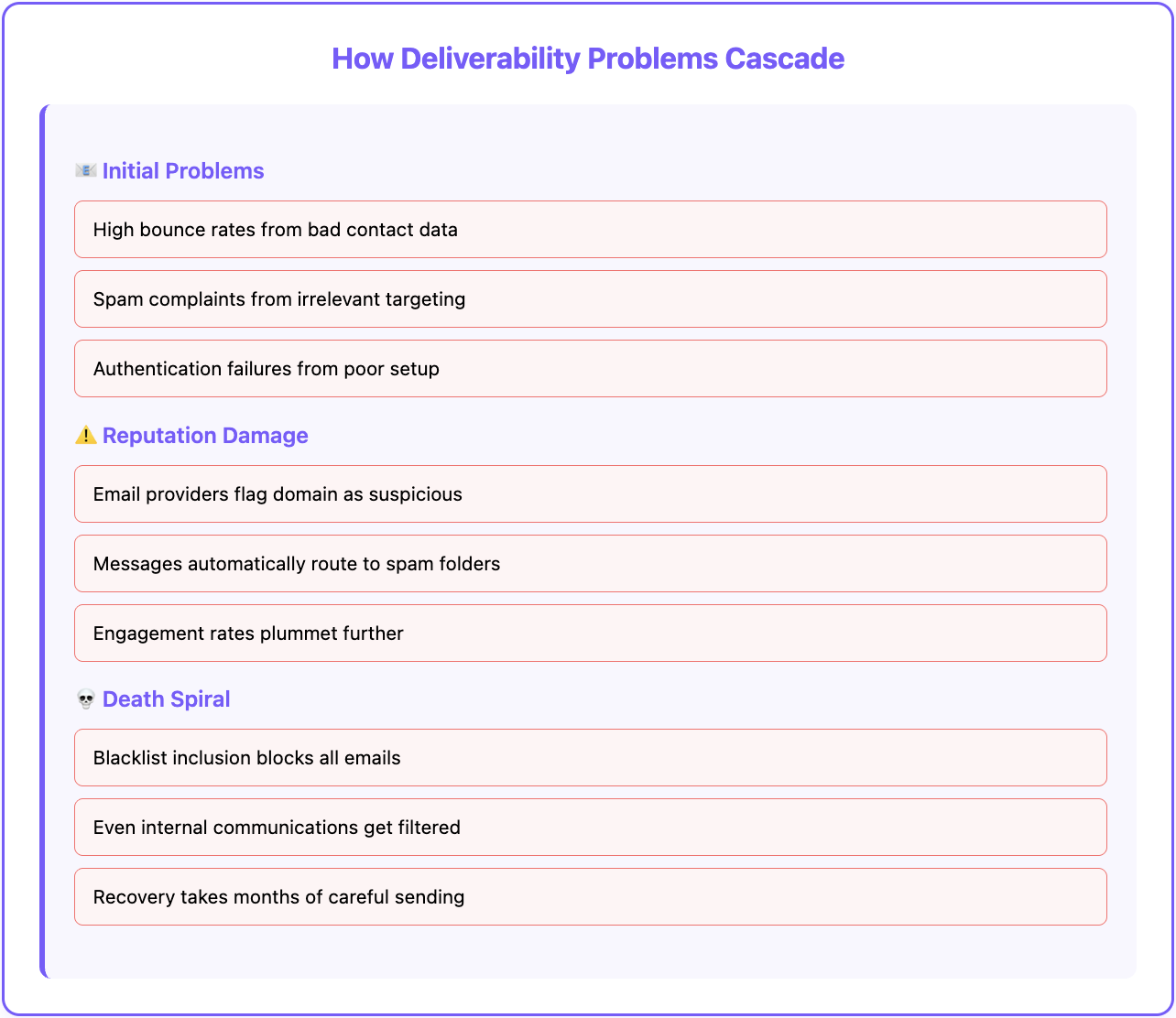
The Bounce Rate Death Spiral
Bounce rates above 5% trigger automatic scrutiny from major email providers. Gmail's documentation explicitly states: "If messages start bouncing or being deferred, reduce sending volume until the SMTP error rate decreases."
Hard bounces occur when emails are sent to non-existent addresses. These permanent failures immediately damage sender reputation because they indicate poor list hygiene or potentially harvested contact data. Soft bounces happen due to temporary issues like full inboxes or server problems, but consistent soft bounces often convert to hard bounces over time.
The compound effect of bounces creates accelerating damage. As bounce rates increase, more future emails get filtered, creating additional bounces when legitimate addresses don't respond. This feedback loop can quickly destroy a domain's sending reputation.
Spam Trap Catastrophes
Spam traps are email addresses specifically designed to catch unwanted senders. These addresses appear valid but don't belong to real people. Sending emails to spam traps immediately signals poor list acquisition practices to email providers.
Pristine spam traps are email addresses created solely to catch spammers. They never sign up for legitimate communications, so any email sent to these addresses indicates list purchasing or scraping. Recycled spam traps are former real email addresses that providers have converted into monitoring tools after periods of inactivity.
The most dangerous aspect of spam traps is their invisibility. Sales teams can't distinguish spam traps from legitimate prospects until they trigger reputation damage. By then, the harm is already done, and sender reputation recovery can take months.
Blacklist - What now?
Email blacklists are databases of IP addresses and domains flagged for spam-like behavior. Major providers like Spamhaus, Barracuda, and SpamCop maintain blacklists that email servers query before accepting messages.
Different blacklists carry different weight with email providers. Being listed on Spamhaus significantly impacts deliverability because most major email services trust their assessments. Smaller blacklists might have minimal impact if few providers reference them.
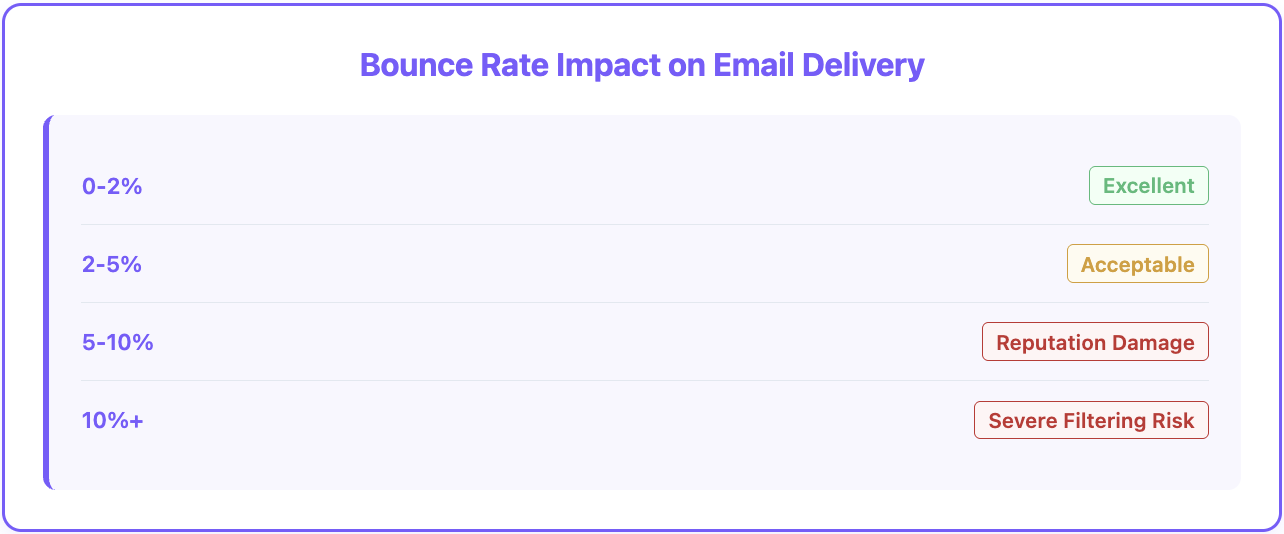
Getting blacklisted creates immediate and severe consequences:
• Complete delivery failure - Emails from blacklisted domains get blocked entirely rather than filtered to spam folders
• Reputation contamination - Blacklist status affects all emails from the domain, including internal communications and customer service messages
• Recovery complexity - Removal from blacklists requires proving behavior changes and can take weeks or months to complete
• Ongoing monitoring - Some blacklists automatically re-add domains that return to problematic sending patterns
The threshold for blacklisting has become lower as spam volumes increased. What might have been tolerable sending behavior five years ago can now trigger immediate blacklist inclusion.
The Million-Dollar Mistake
Sender reputation damage from sales outreach compounds over time, creating increasingly expensive problems that many organizations don't recognize until it's too late.
Volume Without Strategy
Most sales teams approach cold email like traditional marketing - sending large volumes quickly to maximize reach. This approach devastates deliverability for domains without established sending reputations.
Email providers expect gradual volume increases that demonstrate organic growth rather than sudden spam-like behavior. New domains should start with 50-100 emails daily (split across multiple domains) and increase slowly over weeks or months. Sending 1,000+ emails immediately from a new domain almost guarantees cold email deliverability problems.
Consistent sending patterns matter more than peak volumes. Providers prefer domains that send steady volumes rather than erratic bursts. A domain that sends 200 emails daily for months builds better reputation than one sending 5,000 emails sporadically.
The Unsubscribe Paradox
Many cold email senders avoid including unsubscribe links because they worry about giving prospects easy exit options. This strategy backfires dramatically from a deliverability perspective.
Legal requirements like CAN-SPAM and GDPR mandate unsubscribe mechanisms for most commercial emails. More importantly, recipients who can't easily unsubscribe often mark messages as spam instead, which damages sender reputation far more than unsubscribes.
Paradoxically, emails with clear unsubscribe options often perform better because they signal legitimate, professional communication. Providers view unsubscribe links as positive reputation indicators rather than weaknesses.
Content That Screams "Spam"
Cold email deliverability problems often stem from content optimization that focuses on persuasion while ignoring deliverability considerations that most copywriters overlook.
HTML-heavy emails with multiple images trigger automatic suspicion because they resemble promotional marketing rather than personal communication. Plain text or minimal HTML formatting improves deliverability while maintaining a personal tone.
Link density affects filtering decisions. Emails with multiple tracked links, social media buttons, and promotional banners look like marketing blasts rather than individual outreach. Successful cold emails often include no links at all, focusing entirely on starting conversations.
Attachment inclusion significantly increases filtering risk. Files attached to cold emails trigger security scans and often get blocked entirely. Even legitimate attachments like proposals or case studies can prevent delivery to security-conscious organizations.
How Modern Email Providers Fight Back
Email bounce rate impact on sales has intensified as major providers implemented stricter filtering policies throughout 2024 and 2025.
Gmail Setup
Gmail's 2024 spam filtering updates specifically target bulk senders who don't follow authentication and engagement best practices. The changes affect all senders, not just traditional email marketers.
New requirements include mandatory authentication for any sender reaching significant volumes. Domains without proper SPF, DKIM, and DMARC setup face automatic filtering regardless of content quality.
Engagement-based filtering has become more sophisticated. Gmail now tracks how recipients interact with emails from specific domains over time. Domains generating low engagement rates face increased filtering even when individual emails aren't overtly spammy.
The "Promotions" tab diversion affects cold emails that Gmail's algorithms classify as promotional. While not technically spam filtering, promotions tab placement significantly reduces open rates and engagement.
Microsoft's Security Focus
Microsoft's 2025 authentication requirements mirror Gmail's policies while adding additional security layers for organizational accounts.
Office 365 and Outlook.com employ advanced threat protection that analyzes email content for potential security risks. This protection often catches legitimate cold emails that mention competitive intelligence, industry challenges, or business changes.
Sender reputation damage affects entire organizations when Microsoft flags sending domains. Unlike individual email filtering, domain-level blocks prevent delivery to all Microsoft-hosted email addresses.
The AI-Powered Arms Race
Machine learning algorithms now analyze sending patterns that would be impossible for humans to detect manually.
Behavioral analysis tracks timing patterns, content variations, and recipient responses to identify automated sending tools. Ironically, this means that tools designed to personalize cold emails at scale often trigger automated detection.
Cross-platform reputation sharing means that problems with one provider increasingly affect relationships with others. A domain flagged by Gmail may face scrutiny from Yahoo, Microsoft, and smaller providers who share threat intelligence.
What’s The Cost of Deliverability Failure?
Cold email deliverability problems create compound costs that extend far beyond individual message failures, affecting entire sales operations and business growth potential.
Revenue Impact Calculations
When 17% of emails never reach inboxes, the revenue impact compounds across every campaign. A sales team sending 10,000 emails monthly loses 1,700 potential touchpoints before content even matters.
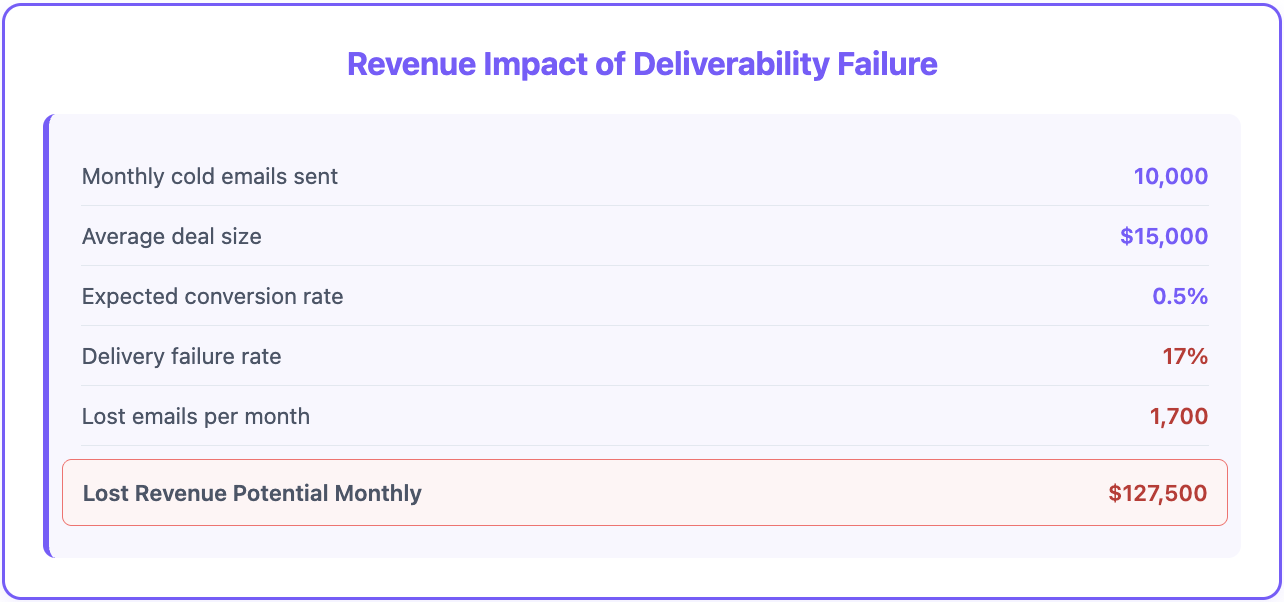
Email deliverability issues cold outreach teams face concentrate losses among the most engaged prospects. Email providers are more likely to filter messages to recipients who rarely engage with cold outreach, but they also filter to engaged recipients when sender reputation degrades sufficiently.
Calculation of deliverability cost:
- 10,000 monthly cold emails
- Average deal size: $15,000
- Expected conversion rate: 0.5%
- 17% delivery failure = 1,700 lost emails
- Lost revenue potential: $127,500 monthly
These calculations assume uniform delivery failure, but reality is worse. As sender reputation degrades, delivery failure rates increase, creating accelerating losses rather than steady ones.
Operational Efficiency
Cold email deliverability problems force sales teams to work harder for worse results. Representatives spend time crafting messages that never reach prospects, following up on emails sitting in spam folders, and researching accounts they can't effectively contact.
Lead qualification becomes impossible when prospects don't receive initial outreach emails. Sales teams may disqualify promising accounts as "unresponsive" when the actual problem is message delivery.
Campaign optimization efforts get misdirected when teams blame content, timing, or targeting for problems actually caused by email deliverability issues cold outreach systems create. Representatives waste time A/B testing subject lines when the real issue is that emails aren't reaching inboxes.
Competitive Disadvantage
Sender reputation damage compounds competitive disadvantages in markets where timing matters for prospect engagement.
While your emails sit in spam folders, competitors with better deliverability reach the same prospects first. Since 35-50% of sales go to vendors who respond first, cold email deliverability problems directly enable competitor success.
Reputation damage persists long after fixing underlying problems. Domains that recover from blacklists or reputation issues still face ongoing scrutiny from email providers, requiring months of careful sending to rebuild trust.
How Databar Solves Email Deliverability Issues Cold Outreach Teams Face
Email deliverability success requires more than just clean contact data - it demands systematic approaches that address authentication, reputation management, and ongoing monitoring.
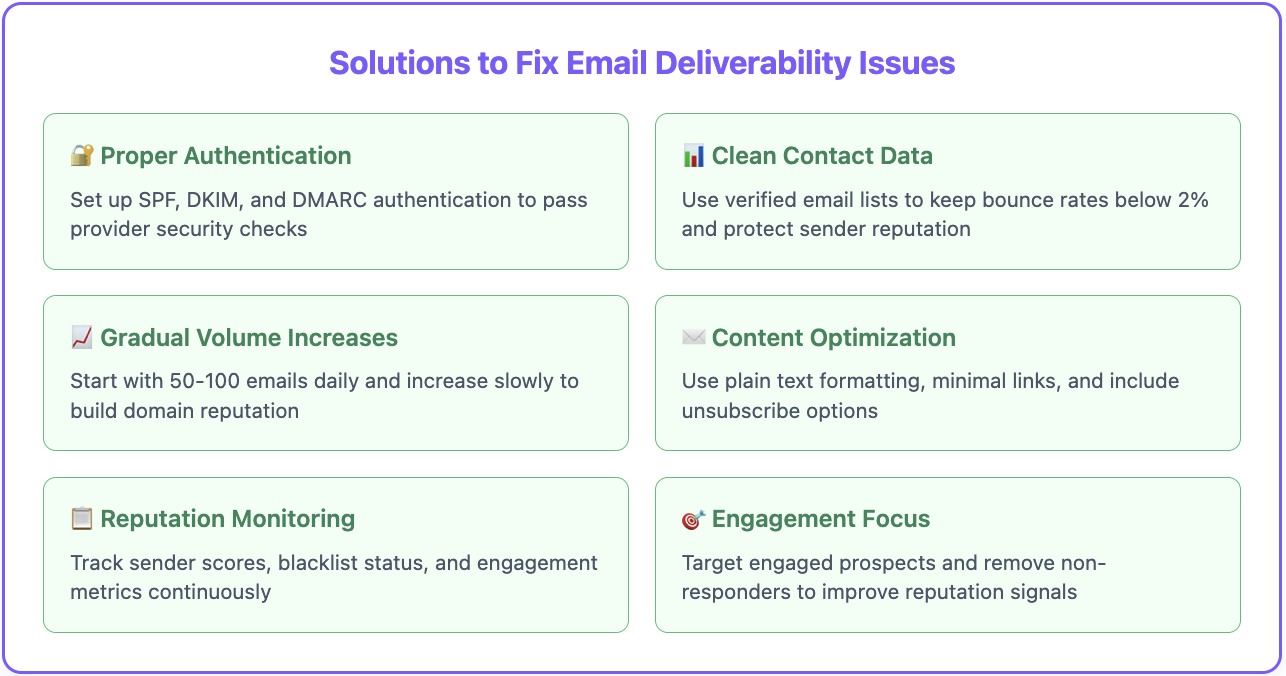
Verified Contact Infrastructure
Instead of hoping your contact data is accurate, Databar provides pre-verified email addresses from multiple data sources that dramatically reduce bounce rates before they impact your sender reputation.
Multi-provider email verification including tools like ZeroBounce, Bouncer and Emailable ensures higher accuracy than single-source validation.
Real-time verification prevents stale data accumulation that gradually increases bounce rates over time. Unlike static lists that decay rapidly, Databar's verification happens at the point of use, ensuring current accuracy.
Databar integrates with existing sales tools without forcing teams to change their preferred email platforms or CRM systems, while maintaining deliverability best practices across all channels.
What’s to Expect For The Future of Cold Email Deliverability?
Email deliverability issues cold outreach teams face will only intensify as providers implement more sophisticated filtering mechanisms and regulatory requirements become stricter.
Emerging Challenges
Machine learning algorithms will become more sophisticated at detecting automated sending patterns, making it harder for sales teams to scale personalized outreach without triggering spam filters.
Cross-platform reputation sharing will expand, meaning that problems with one email provider will increasingly affect relationships with all major providers.
Regulatory compliance requirements will become more complex as privacy laws evolve globally, requiring sales teams to maintain detailed consent records and processing documentation.
Competitive Advantages
Organizations that invest in proper email deliverability infrastructure now will capture increasing market share as competitors struggle with sender reputation damage and delivery failures.
Technical expertise in authentication, reputation management, and list hygiene will become competitive differentiators rather than basic requirements.
Data quality will determine which companies can execute effective outbound strategies while others lose the ability to reach prospects entirely.
The companies that solve cold email deliverability problems systematically will dominate markets where others can't even start conversations.
Your cold emails are only as effective as your ability to deliver them. Content, timing, and targeting become irrelevant when messages disappear into spam folders or bounce back to your server. The teams that prioritize deliverability alongside persuasion will dominate markets where others can't even start conversations.
For additional insights on optimizing sales performance through better data management, our analysis of why sales teams miss quota due to one hidden problem reveals how foundational data issues compound across all aspects of sales execution.
The choice is clear: continue losing opportunities to email deliverability issues cold outreach teams face, or implement the infrastructure that ensures your messages reach the prospects who need to hear from you. While competitors wonder why their emails don't get responses, your team will be booking meetings with prospects who actually receive your outreach.
FAQs
What causes email deliverability issues in cold outreach?
Email deliverability issues cold outreach teams face stem from high bounce rates, poor sender reputation, lack of authentication, spam complaints, and blacklist inclusion. These problems compound over time, making future emails less likely to reach inboxes.
What is a good bounce rate for cold emails?
A bounce rate below 2% is acceptable for cold emails. Email bounce rate impact becomes severe above 5%, triggering scrutiny from email providers and damaging sender reputation. If your bounce rate exceeds this threshold, pause campaigns immediately and verify your contact data quality.
How do I know if my domain has sender reputation damage?
Signs of sender reputation damage include dramatically decreased open rates (falling from 40% to 5%), emails consistently landing in spam folders, and bounces with specific error messages about reputation. Use tools like Sender Score or MXToolbox to check your domain status.
Can I fix cold email deliverability problems by changing content?
Content optimization helps, but cold email deliverability problems usually stem from technical issues like authentication, bounce rates, or sender reputation. Focus on fixing underlying infrastructure problems before optimizing message content.
How long does sender reputation recovery take?
Sender reputation recovery typically takes 2-3 months of consistent good sending practices. This includes maintaining low bounce rates, avoiding spam complaints, and gradually increasing sending volumes. Recovery time depends on the severity of reputation damage.
Should I include unsubscribe links in cold emails?
Yes, include unsubscribe links in cold emails. Legal requirements mandate them in most jurisdictions, and email providers view unsubscribe links as positive reputation signals. Recipients who can't unsubscribe easily often mark emails as spam instead, which damages sender reputation more than unsubscribes.
What happens if I continue sending with high bounce rates?
Continuing to send emails with high bounce rates creates a downward spiral. Email bounce rate impact will worsen as email providers increasingly filter your messages, potentially leading to blacklist inclusion. Eventually, even emails to valid addresses won't be delivered.
How do I prevent email deliverability issues cold outreach campaigns face?
Prevent email deliverability issues cold outreach campaigns face by: setting up proper authentication (SPF, DKIM, DMARC), maintaining clean contact lists, starting with low sending volumes, monitoring bounce rates continuously, and avoiding spam trigger words in content.
Is it better to use a dedicated IP for cold email?
Dedicated IPs provide more control over sender reputation but require careful management. They're beneficial for high-volume senders who can maintain consistent sending patterns. Shared IPs work for smaller volumes but risk sender reputation damage from other users' sending practices.
Related articles
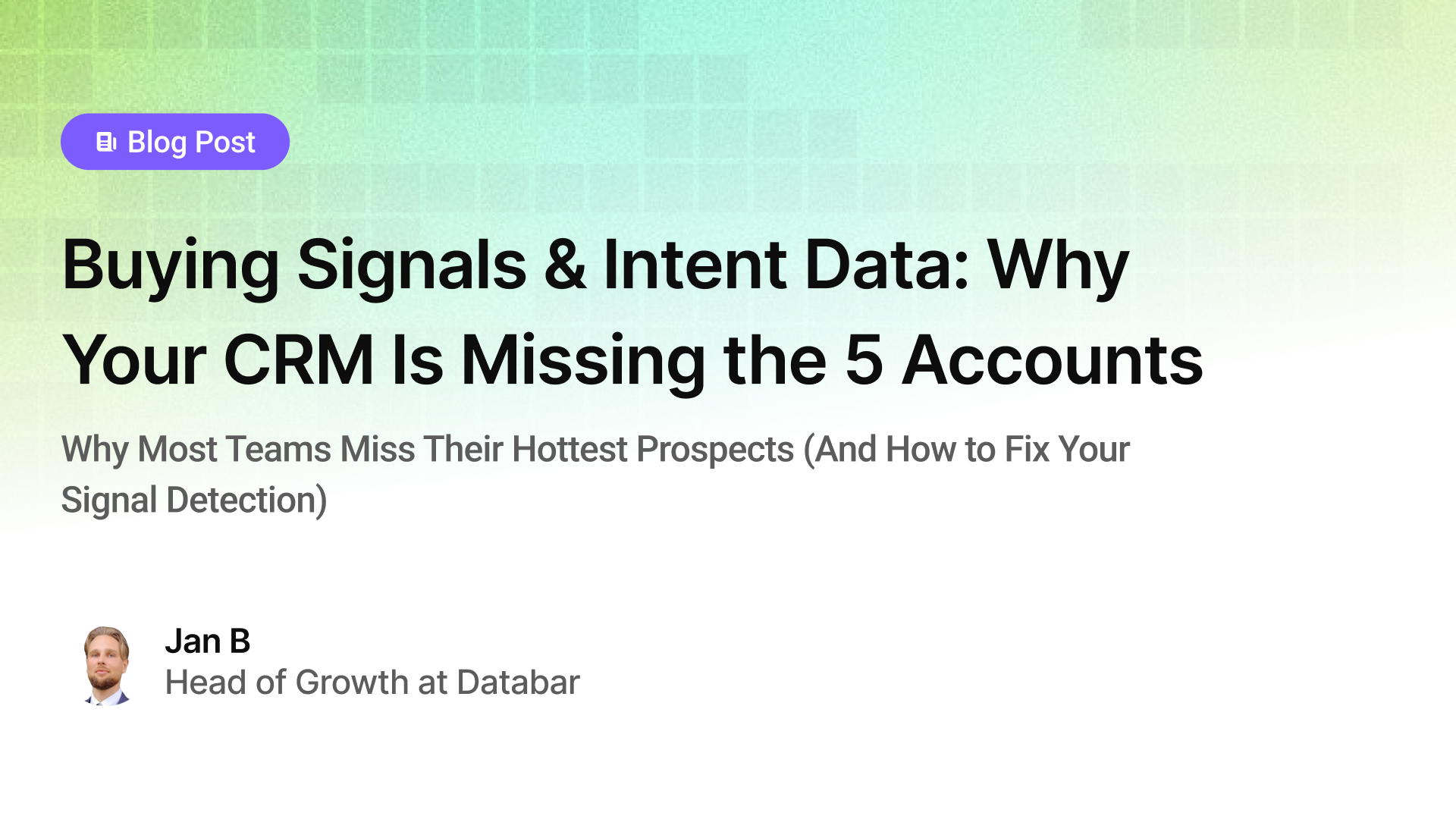
Buying Signals & Intent Data: Why Your CRM Is Missing the 5 Accounts
Why Most Teams Miss Their Hottest Prospects (And How to Fix Your Signal Detection)
by Jan, October 06, 2025

Lead Scoring & Account Segmentation: Why Most CRMs Get This Backward (And How to Fix It)
How to build a system that tells your team who to call, when, and why
by Jan, October 06, 2025
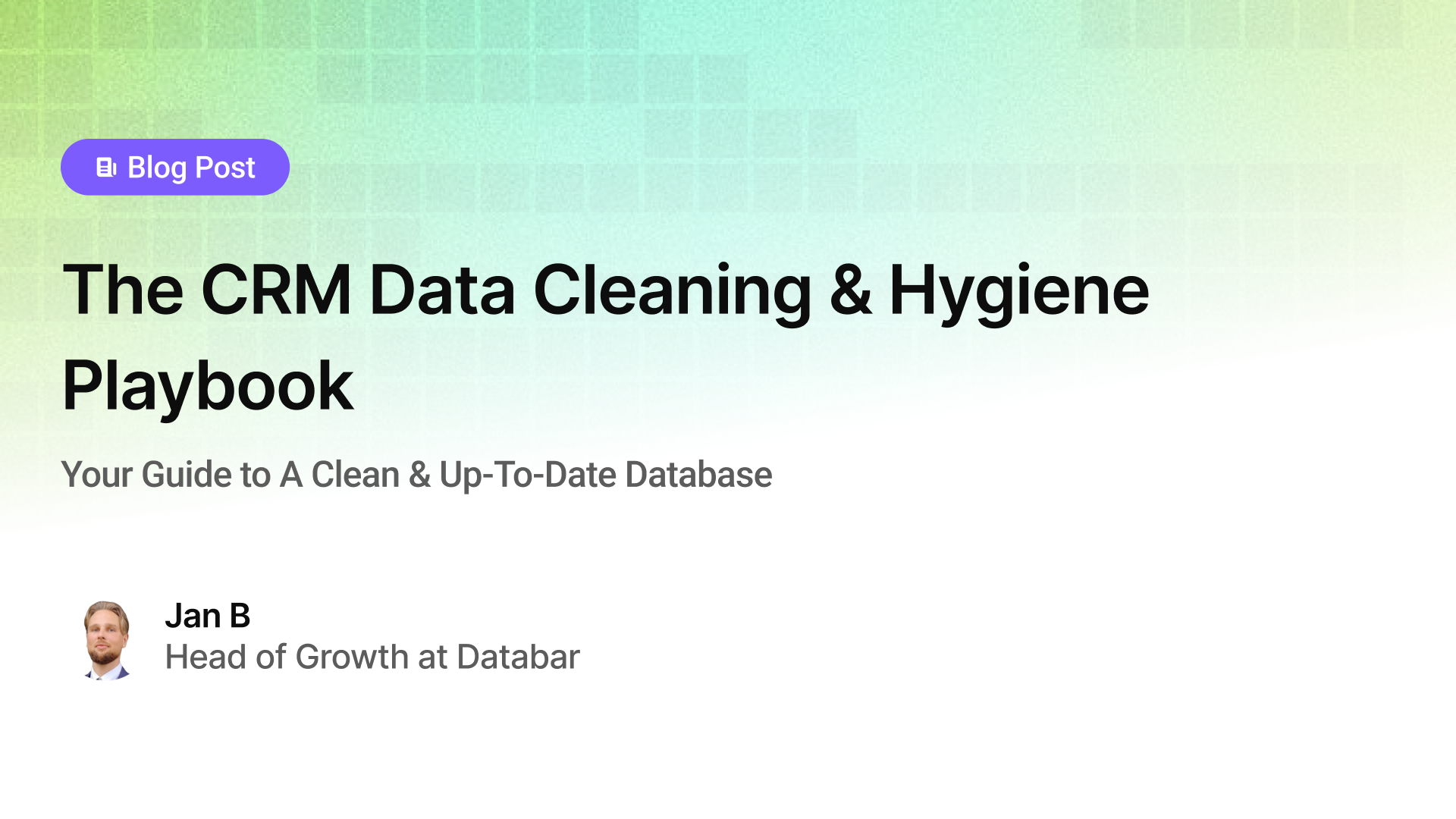
The CRM Data Cleaning & Hygiene Playbook
Your Guide to A Clean & Up-To-Date Database
by Jan, October 04, 2025
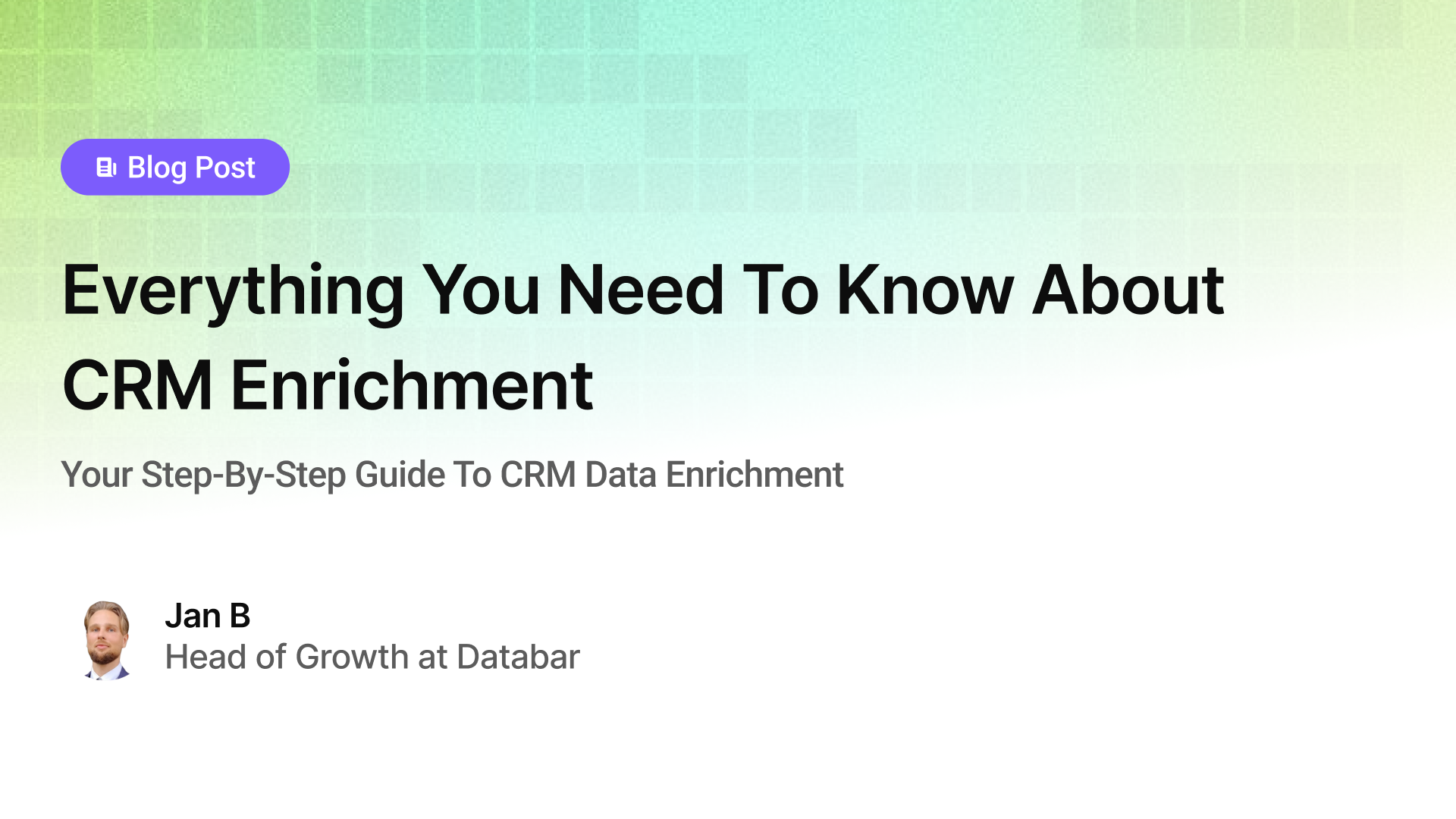
Everything You Need To Know About CRM Enrichment
Your Step-By-Step Guide To CRM Data Enrichment
by Jan, October 03, 2025

